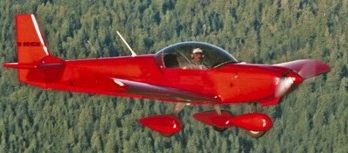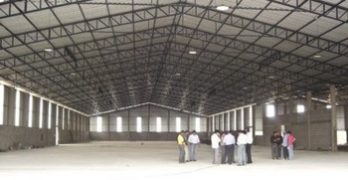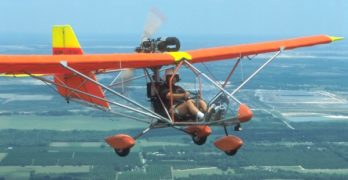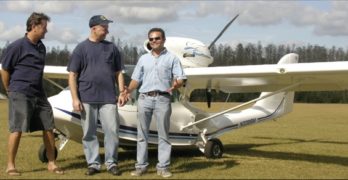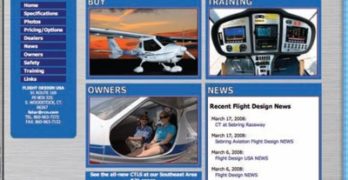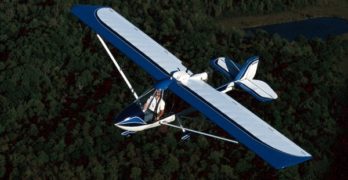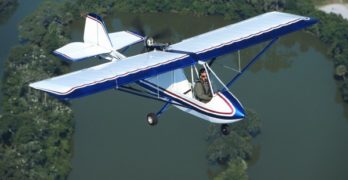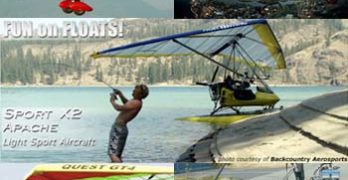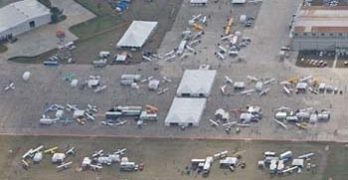In a Safety Recommendation released Apr. 14, the National Transportation Safety Board (NTSB) “has investigated a series of in-flight structural breakups of Zodiac CH-601XL airplanes designed by Zenair, Inc…in the United States in the last 3 years. The Safety Board is also aware of several in-flight structural breakups of CH-601XLs that have occurred abroad. It appears that aerodynamic flutter is the likely source of four of the U.S. accidents and of at least two foreign accidents. The Safety Board believes urgent action is needed by the Federal Aviation Administration (FAA) to prevent additional in-flight breakups. Two of the accident airplanes were classified as Special Light Sport Aircraft (S-LSA).” *** In six of the breakups, NTSB noted 10 people were killed. *** Aerodynamic flutter occurs when aerodynamic and structural forces interact and lead to unsafe structural vibration in the airplane. Left undamped, the vibrations can quickly lead to structural failure. *** NTSB’s urgent recommendation to the FAA is to prohibit further flight of the CH-601XL until it can determine the airplane is no longer susceptible to aerodynamic flutter.
Search Results for : CT AND hand control
Not finding exactly what you expected? Try our advanced search option.
Select a manufacturer to go straight to all our content about that manufacturer.
Select an aircraft model to go straight to all our content about that model.
Sunny Side Up!
Somebody forgot to tell Paradise Ind. Aeronautica about the major global economic meltdown. Chris Regis of Paradise, (see my spots about their acft. below), tells me the company just opened its new 70,000-square-foot-plant in Brazil, which will produce 120 airplanes per year. *** Customers can even keep track of their airplane’s construction progress on the internet thanks to a remote camera system on the assembly line! How cool is that? *** Paradise makes the P1 and P1 SP (with all-hand controls for disabled pilots). Their aircraft (look for my report on both models in an upcoming issue of Plane & Pilot) are built in Brazil and assembled, outfitted and test flown in Sebring, FL. *** Price is in the $109,000-$120,000 range, depending on avionics and options. *** Pix as soon as I get ’em from Chris.
Aero-Lite Revisited
[UPDATE fall 2009 — Aero-Works left the business several years ago (though in late 2009, originator Terry Raber said he will return to production). Meanwhile, producer Wings of Freedom has begun work on the Phoenix-103, a derivation of the Aero-Lite 103 but with numerous small changes.
This article refers to the aircraft built by AeroWorks and will not be identical to the Aero-Lite 103. The companies are different and Terry Raber has no association with Wings of Freedom.
In the uncertain “new world of Sport Pilot,”
one thing remains exactly as it was – FAR Part 103. While new rules and regulations may shake the ground under the feet of ultralight pilots, Aero-Works continues to produce their popular AeroLite 103. If you build it carefully, you can still enjoy a twin-cylinder ultralight with lots of features that fits Part 103.
Even airline pilots who normally fly under smothering regulations appreciate FAA’s simplest, least intrusive rule, Part 103.
AirMax SeaMax, Elegant Engineering
Let’s consider light amphibious aircraft – the boathull variety, not floatplanes
– but including both freshly designed, fully built light sport aircraft
along with kit aircraft born of the ultralight heritage.
In the last year, the exceedingly handsome Icon A5 has made quite a splash, literally
and figuratively. However, the A5 is more than a year away from first deliveries
and an order placed today might not be delivered until 2011 or later. Another LSA
amphibian called the Mermaid was designed and introduced by Czech Aircraft
Works of SportCruiser fame. Although five are available in the country, sales have
yet to take off.
Another popular American seaplane, the SeaRey, is moving toward ASTM
approval but remains a kit that asks several hundred hours of a builder’s time. The
simpler and faster-build Aventura models also remain available; this design has
been on the market for many years. Either kit is less costly than a fully built aircraft,
but all seaplanes have loftier price tags to cover their ability to operate on land
or water.
SLSA Service After the Sale
Most folks have probably never heard of ASTM International document F2295, Continued
Operational Safety Monitoring of a Light-Sport Aircraft. But Tom Peghiny, president of
Flight Designs USA, is intimately familiar with it. As the former chairman of the ASTM
Airplane Committee, Tom was a driving force behind requiring SLSA manufacturers to
face up to service after the sale and airworthiness monitoring. According to Tom, “The
SLSA industry will not survive unless we take our after-sale commitments seriously.
SLSA Service After the Sale Flight Design USA has a dedicated safety and compliance manager plus a number of
procedures in place to make sure customers get the service they need.”
Flight Design USA initiates its after-sale quality control by starting in the
beginning. Any individual involved in the assembly of CT airplanes imported into
the United States must undergo assembly compliance training through Lockwood
Aviation’s Aero Technical Institute. Thus customers are assured that their CTSW or CTLS
meets all original manufacturer quality standards.
Light-Sport Aircraft… Leading the Way Up?
Sebring was a welcome event for all who participated. Companies that stayed home may be wondering if that was the right move. With record crowds, airplane orders taken, and merchandise selling out, the Florida LSA show gave a welcome lift to a global aviation industry that’s been laying off workers by the thousands. But, besides the general good news I’ve been asked dozens of times, “What was new?” at the event. Here’s my list; details will follow in other SPLOG posts. Surely I’ll leave out some worthy aircraft (you’ll tell me, I hope, and I’ll include them). *** In no particular order…the well-proven RANS S-6 Coyote debuted as an SLSA; Urban Air’s newly certified Samba complements their lovely Lambada; FPNA’s amphibious Cape Town appeared on brand-new floats; Paradise delivered their first hand-control P-1; Remos debuted their GX 2009 with new gear and a redesigned interior; a year after its debut at Sebring ’08 CTLS displayed the first-ever Garmin 696 installation, while the avionics company announced their GDU 370 and 375 MFDs; Evektor showed their SportStar SL with a recontoured exterior; Tony and Adriel Anderson showed their Fk9 on new Baumann amphib floats; they’re teaming up for sales with Hansen Air Group, which also showed a production version of their new FA-04 Peregrine; Zenith Aircraft constantly demo flew the STOL CH-750, an upgrade from their popular 701; Cessna identified notable changes in the final Skycatcher design (a larger tail) and confirmed first deliveries in ’09; and, the K-10 from Ukraine-based Skyeton made its worldwide debut…and made a sale.
Modestly-Priced, Easy-Flying Challenger Series
For 21 Years, Quad City’s Challenger has proved a good choice.
It’s enough to create a serious case of envy among producers vying for the market the Challenger seems to own year after year. Even in 2003, a slow year for all aircraft manufacturers, Quad City Ultralight Aircraft pumped out another 120 kits. Most light-sport aviation companies would consider that an excellent performance. For Quad City, it was a down year!
The venerable company from the Quad Cities area of Iowa, near the Illinois border, has put more than 3000 aircraft in the air. Van’s Aircraft has done even better, and Quicksilver has more than 10,000 ultralights flying, but the Challenger is clearly one of the industry’s leaders. And the company has enjoyed the same leadership since it was founded more than two decades ago.
Despite this success, Quad City maneuvers rather quietly. Last year the company celebrated 20 years of operation, yet many ultralighters and most aviators were unaware of the accomplishment.
Successful Low-Cost Light Planes
“I started the company in 1983, and I still own it,” reports Dave Goulet, the main man behind the Challenger aircraft design and Quad City Ultralight Aircraft Corporation. “In fact,” he adds, “it’s probably the oldest ultralight company still under the same management. “After reviewing all the ultralight companies I can think of, I’m inclined to agree.”
Thinking of other long-term operations, Goulet mentions The New Kolb Aircraft Company, whose roots are also planted deep, but even that storied company has now changed ownership… twice in the last decade, and most recently just a couple years ago.
Quicksilver Mfg. has been around longer, but the revolving door of managers and several changes of ownership have long since taken that familiar brand out of contention for continuous leadership.
About the only challenge to Challenger’s continuity reign that I can think of would be Chuck Slusarczyk, designer of the Hawk series, and his company, CGS Aviation.
Think All Trikes Are Foreign? Think Again!
Weight-shift control LSA, affectionately referred to as “trikes,” are often made overseas. That’s a bit weird as the concept originated in the USA and spread around the globe. Tens of thousands are flying, despite their relative rarity in America. So you could be excused for viewing trikes as foreign. Not all of them… *** Though it won approval last summer, the newest SLSA in the game — we now have 89 models from 67 companies — is the North Wing Design Sport X2, available in two models plus ELSA versions with alternate engines. The Navajo may represent the least expensive SLSA you can purchase, retailing for $29,000 ready-to-fly. An Apache model is more dressed out and runs $32,000, still quite a bargain in today’s world of $135,000 SLSA airplanes. (More price info.) *** North Wing is an all-American company from Washington state making both trike carriage and wings.
Sebring 2009; Kicking Off a New Year for LSA
Despite a widespread financial funk, the Sebring U.S. Sport Aviation Expo — commonly referred to as the Sebring LSA Expo — is fast approaching. This #5 Sebring starts the year and has become a place where new aircraft debuts are staged. Yes, a few exhibitors have pulled out to conserve cash. But most aircraft you want to see will be present. *** Paradise will have their new hand control P-1. A CTLS with the new Garmin 696 installed will be on display. An upgraded Remos GX will show…and the list goes on. *** One new LSA entry you’ll see will be the all-American Lightning LS-1 (photo) from Arion Aircraft. Though powered by Australia’s Jabiru engine the entire airframe is Made-in-the-USA. I flew a kit-built version and was highly impressed by its performance and handling. Lightning’s speed range was one of the widest I’ve ever experienced.
- « Previous Page
- 1
- …
- 39
- 40
- 41
- 42
- 43
- …
- 62
- Next Page »


